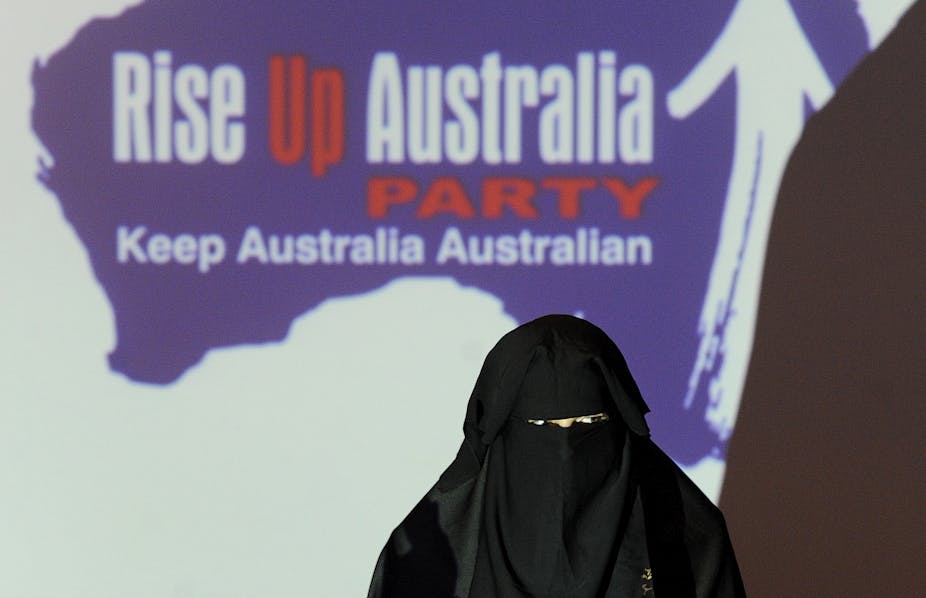The burqa and niqab are often viewed as symbols of extremism. In the wake of the rise of Islamic State, it is unsurprising, therefore, that in recent days a number of Australian politicians have called for their banning.
Reverend Fred Nile has already introduced the Summary Offences Amendment (Full-face Coverings Prohibition) Bill 2014 (NSW) into the New South Wales parliament which, if passed, will ban the wearing of various face coverings in public. The Bill does not refer to Muslims, Islam, the burqa or niqab. Comments by Nile clearly indicate, however, that the law is designed to target Islamic face veils.
While the proposed ban, if passed, would affect only a small number of women, it would force them to make unenviable choice. Obey the law and deny their faith. Obey their faith and risk criminal charges. Stay at home and become isolated from the community.

Government senator Cory Bernardi and Palmer United Party senator Jacqui Lambie have also called for the burqa to be banned. In a tweet Bernardi linked recent raids on suspected terrorists to the burqa, claiming that burqa wearers had been found in several of the houses raided.
Nile made three arguments in support of his legislative ban. First, several European countries have banned face coverings in public or are considering such a ban. Second, criminals and terrorists can use face coverings such as the burqa and niqab to hide their identities. Third, women are forced to wear the Islamic face veil by their families and religion.
This is not the first time Nile has tried to ban face coverings. In 2010 and 2011 he unsuccessfully introduced similar Bills. There are two key differences between then and now: the handing down of the European Court of Human Rights’ decision on the French burqa ban and the rise of Islamic State.
In July this year, the European Court of Human Rights upheld France’s ban on face coverings in public. The court found that the ban impinged upon the freedom of religion of Muslim women. However, it found that the ban was permissible to promote the minimum requirements of life in society or living together (le vivre ensemble). The decision has been heavily criticised.
Blowing the dog whistle
While the court ultimately found that the ban was permissible, it rejected a number of arguments put forward in support of the ban. This includes those relied upon by Nile.
His arguments rests heavily on the assertion that a ban on face veils is necessary to protect public safety. He has explicitly linked this latest push to ban the burqa to the rise of Islamic State.

Criminals and terrorists can and do use face coverings to hide their identities. However, a blanket ban is not the only solution. New South Wales, the Australian Capital Territory and Western Australia have all passed laws dealing with face coverings in public.
Police have been given the power to request a person remove their face covering for the purposes of checking their identity. This is a proportionate and sensible approach. Face veils can, in certain circumstances, impede identification and pose a security risk. However, there is no security threat from women wearing the burqa while having coffee at their favourite café.
While some supporters of Islamic State may wear the burqa, it does not necessarily follow that the two issues are linked. The attempts by Nile, Bernardi and Lambie to draw a link are little more than a dog whistle to the frightened and intolerant.
The direct security threat posed the face veil is very low. Only 2.2% of the population is Muslim. An even smaller fraction wear the face veil. Only one instance of the burqa being used as a disguise in the commission of a crime has been recorded in Australia.
Tolerance is a source of strength
While fighters returning from overseas conflicts, including those fighting for Islamic State, do pose a security threat, banning face coverings is little more than a knee-jerk reaction. Such a ban is more likely to inflame tensions within Australia’s Muslim community.
Lambie argued that the burqa should be banned because:
The burkas are obviously designed by men who have an obsessive need to have extreme control and power over women.
However, the European Court of Human Rights rejected the argument that a ban on the burqa was necessary to promote equality between men and women. The court commented that:
… A State Party cannot invoke gender equality in order to ban a practice that is defended by women.
The applicant in that case strongly asserted that wearing the face veil was her choice. That she, along with many other women, chose to wear the face covering as a sign of devotion and even empowerment.
Even if some women are forced to wear the face veil, a ban is not the best solution. Banning the face veil will not result in oppressed women throwing off their veils and revelling in their new-found freedom. Instead, the more likely result is their exclusion from society as their oppressors force them to remain at home.
Rather than encouraging tolerance, pluralism and respect, a ban on the burqa simply removes the face veil from the public. Studies conducted in France and Belgium point to an increase in intolerance, even violence, towards women wearing face veils after the introduction of the ban in those countries.
Instead of following France and Belgium, Australia should continue to seek measures to accommodate a diverse range of religious expressions.
Rather than feeling uncomfortable when seeing a veiled woman, Australians should feel proud. Our society is tolerant and open-minded enough for a diverse range of religious beliefs and practices, which includes wearing the burqa and niqab.

